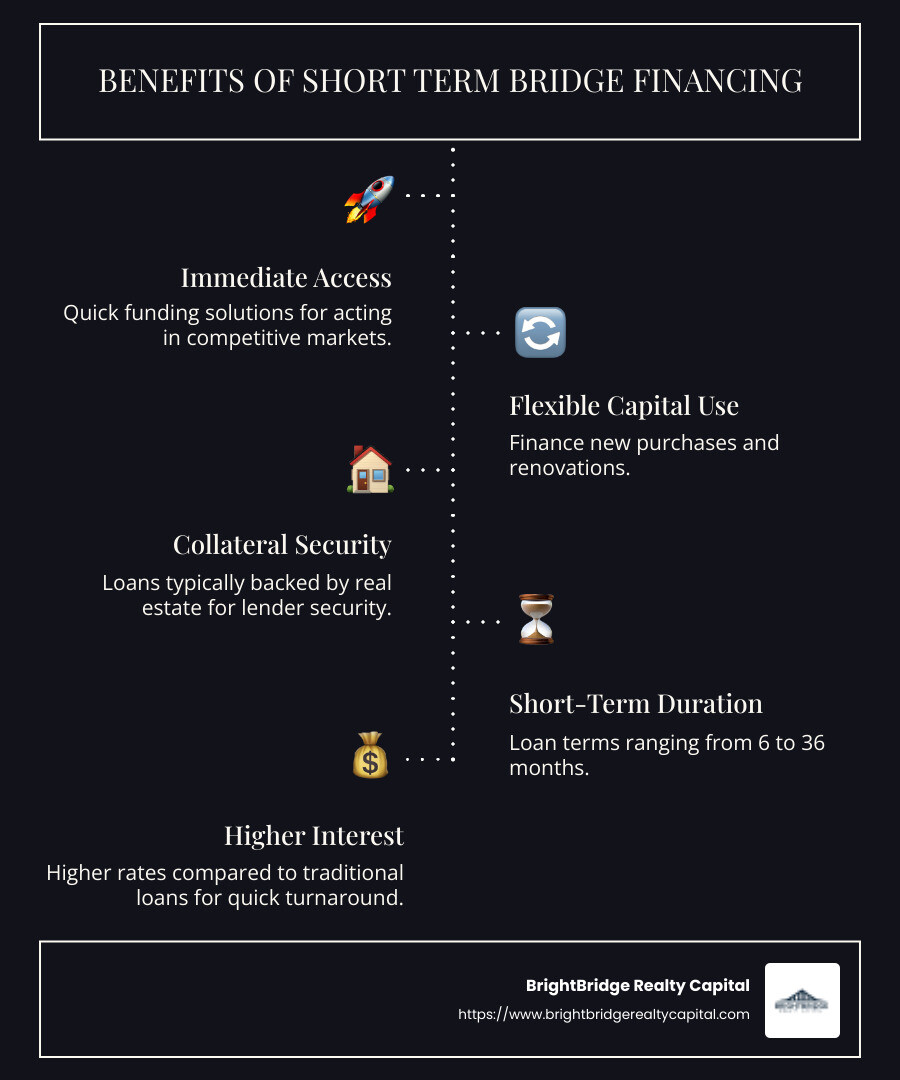The Ins and Outs of Short Term Bridge Financing

Short term bridge financing is a crucial tool in the real estate world, designed to fill the gap when traditional funding just isn't fast enough. These short-term loans provide real estate investors with the immediate cash flow needed to seize opportunities without delay.
Here's a quick snapshot of what this type of financing offers:
- Immediate Access to Funds: Bridge loans are designed to offer quick solutions, allowing investors to act swiftly in competitive markets.
- Flexible Use of Capital: They can cover everything from purchasing new properties to renovating existing ones.
- Secured by Collateral: Typically backed by real estate, ensuring a degree of security for lenders.
- Short-Term Nature: Typically lasting 6 to 36 months, intended as a stopgap until long-term financing is secured.
- Higher Interest Rates: These loans come with higher interest rates compared to traditional loans due to their short and flexible nature.
In today's fast-moving real estate market, understanding and utilizing short term bridge financing can be the key to open uping new investment opportunities.

Short term bridge financing word guide:
What is Short Term Bridge Financing?
Short term bridge financing is a temporary loan option that helps bridge the gap during a transitionary period. It's like a financial bridge that helps you move from one phase to another without missing out on opportunities.
Immediate Cash Flow: This type of financing provides quick access to funds. It's perfect for situations where you need cash fast, like buying a new home before selling your current one.
Temporary Solution: These loans are short-term by design, typically lasting anywhere from 6 to 36 months. They're not meant to replace traditional long-term loans but to act as a stopgap until more permanent financing is in place.
Real Estate Focus: In the real estate world, bridge loans are often used to help purchase a new property while waiting for the sale of an existing one. They allow you to tap into the equity of your current home, providing the necessary funds to secure a new property.
Higher Interest Rates: Because these loans are short-term and offer immediate cash flow, they usually come with higher interest rates. But for many, the benefits of quick funding and flexibility outweigh the cost.
Short term bridge financing is all about providing swift, flexible financial solutions to keep your real estate plans on track.

Transitioning to the next section, let's explore how these loans work in more detail, including their applications in both real estate and business.
How Does Short Term Bridge Financing Work?
Short term bridge financing is a powerful tool for both real estate and business scenarios. Let's break down how it works in each context.
Real Estate Applications
In real estate, short term bridge financing is often used to facilitate the purchase of a new home while waiting for the current one to sell. Here's how it works:
Equity and Collateral: Your current home often serves as collateral. This means the equity you've built in your existing property is used to secure the loan. You can then use these funds for a down payment on a new home.
High Interest Rates: Due to the short-term nature and quick access to funds, bridge loans typically come with higher interest rates. While this might seem daunting, the ability to secure a new home without waiting for the old one to sell can be invaluable.
Home Purchase and Sale: This type of financing allows you to act quickly in a competitive housing market. You can make an offer on a new home without a contingency related to selling your current home first.
Selling Current Home: Once your old home sells, the proceeds can be used to pay off the bridge loan, ideally before the loan term ends. This eliminates the need for dual mortgage payments.
Business Applications
For businesses, short term bridge financing serves as a lifeline during periods of financial transition:
Working Capital: Businesses often need immediate cash flow to cover daily operations. Bridge loans can provide the necessary working capital to keep things running smoothly.
Interim Financing: Companies waiting for long-term financing or investment rounds can use bridge loans to cover expenses in the interim. This ensures that operations continue without interruption.
Expenses Coverage: From payroll to rent and utilities, bridge loans can cover essential expenses when cash flow is tight. This provides businesses with the flexibility to manage financial obligations without delay.

In both real estate and business, short term bridge financing offers a strategic advantage by providing quick access to funds when timing is critical. Whether you're securing a new home or keeping your business afloat, these loans can be a vital part of your financial strategy.
Pros and Cons of Short Term Bridge Financing
Pros
Fast Funding: One of the biggest advantages of short term bridge financing is the speed at which you can access funds. Some lenders can approve and disburse these loans in as little as two weeks. This quick access is crucial in competitive real estate markets where timing can make or break a deal.
No Contingency Needed: With a bridge loan, you can make an offer on a new home without the typical contingency of selling your current home first. This makes your offer more competitive, especially in hot markets where sellers are looking for the least complicated deal.
Competitive Offers: Since you can bypass the home sale contingency, your offer stands out to sellers. This can be a decisive factor in securing a property in a market.
Cons
Higher Interest Rates: Bridge loans typically come with higher interest rates compared to traditional loans. This is due to their short-term nature and the quick access to funds they provide. While this might be a downside, the benefits of securing a new home quickly can outweigh the costs.
Dual Payments: If your current home doesn't sell quickly, you may find yourself making payments on both the bridge loan and your existing mortgage. This can strain your finances, especially if the sale of your old home takes longer than expected.
Equity Requirements: To qualify for a bridge loan, you generally need significant equity in your current home, often at least 20%. This can be a barrier for some homeowners who haven't built up enough equity.
Limited Protections: Unlike some traditional loans, bridge loans often come with limited borrower protections. If your home sale falls through and you can't repay the loan, you could face foreclosure on your property.
Short Term Bridge Financing can be a powerful tool, but weigh these pros and cons carefully. Understanding both the benefits and the risks will help you make an informed decision that aligns with your financial goals.
Alternatives to Short Term Bridge Financing
While short term bridge financing can be a quick solution for immediate cash needs, there are other options to consider that might better suit your financial situation and goals. Let's explore some customized financing solutions, custom loan options, and flexible terms available to you.
Customized Financing Solutions
Many lenders offer personalized loan packages custom to your specific needs. These solutions can include a mix of loan types, allowing you to leverage different financial tools to meet your objectives. For example, combining a home equity line of credit (HELOC) with a traditional mortgage might provide the necessary funds without the higher interest rates of a bridge loan.
This approach allows you to tap into the equity of your existing home while benefiting from lower interest rates and extended repayment terms. Plus, with a HELOC, you only pay interest on the amount you actually use, which can be more cost-effective in the long run.
Custom Loan Options
Another alternative to consider is the 80-10-10 loan. This type of loan involves taking out two mortgages and paying 10% down on your new home. With this structure, you can avoid private mortgage insurance (PMI) and potentially reduce your monthly payments.
This option is particularly appealing if you have strong credit but lack the cash for a full 20% down payment. It allows you to secure a new property while managing your financial commitments more effectively.
Flexible Terms
For those who need more flexibility, personal loans can be an option. These loans can be either secured or unsecured, depending on your credit history and financial standing. They offer variable terms and can be custom to your repayment capabilities.
Personal loans might not provide as much funding as a bridge loan, but they often come with more favorable interest rates and terms. This can make them a viable option if you're looking for a flexible, less costly solution to bridge your financial gap.
By considering these alternatives, you can find a financing solution that aligns with your financial goals and circumstances. Whether it's through customized financing solutions, custom loan options, or loans with flexible terms, it's important to explore all avenues before deciding on the best path forward.
Frequently Asked Questions about Short Term Bridge Financing
What are the typical terms for a bridge loan?
Bridge loans are short-term solutions, typically lasting from 6 to 36 months. They are designed to provide quick cash flow during transitions, like buying a new home before selling your current one.
Interest rates on bridge loans are generally higher than traditional loans, ranging from 7% to 10%. This is due to the short-term nature and the risk involved. Repayment terms often include interest-only payments with a balloon payment at the end of the term.
How do I qualify for a bridge loan?
Qualifying for a bridge loan requires a solid financial profile. Lenders typically look for:
- Credit Score: A good credit score is crucial. Most lenders prefer scores of 620 to 740.
- Debt-to-Income Ratio: A low DTI ratio is favorable. Lenders usually look for a DTI below 50%.
- Equity Requirements: You generally need at least 20% equity in your current home to qualify. This equity acts as collateral for the loan.
Having stable employment and a steady income flow also strengthens your application.
What happens if my home doesn't sell in time?
If your home doesn't sell before the bridge loan's term ends, you could face financial strain. You might have to manage two mortgages simultaneously. This can be challenging, especially with the higher interest rates of bridge loans.
Financial Planning is essential. Consider these steps:
- Plan for Dual Mortgages: Be prepared for the possibility of carrying two mortgages. Calculate if your budget can handle this scenario.
- Explore Refinancing Options: If your home doesn't sell, refinancing the bridge loan into a longer-term loan might be an option.
- Consult a Financial Advisor: Professional advice can help you steer the complexities and avoid foreclosure risks.
By understanding these aspects of short term bridge financing, you can make informed decisions and plan effectively for your financial future.
Conclusion
At BrightBridge Realty Capital, we know that every real estate investor's journey is unique. That's why we offer customized solutions custom to meet your specific needs. Whether you're looking to flip a property, start a new construction project, or expand your rental portfolio, our short term bridge financing options can bridge the gap and keep your projects on track.
One of our standout features is our ability to provide fast closings. We understand that timing is crucial in real estate, and our streamlined process allows us to close deals often within a week. This quick turnaround means you can seize opportunities as they arise, without the delays that often come with traditional financing.
Our direct lending approach eliminates intermediaries, ensuring competitive rates and a seamless experience from start to finish. With BrightBridge Realty Capital, you get the financial flexibility you need, backed by a team dedicated to supporting your investment goals.
Ready to explore how our short term bridge financing can work for you? Learn more about our services and find the BrightBridge difference today.


